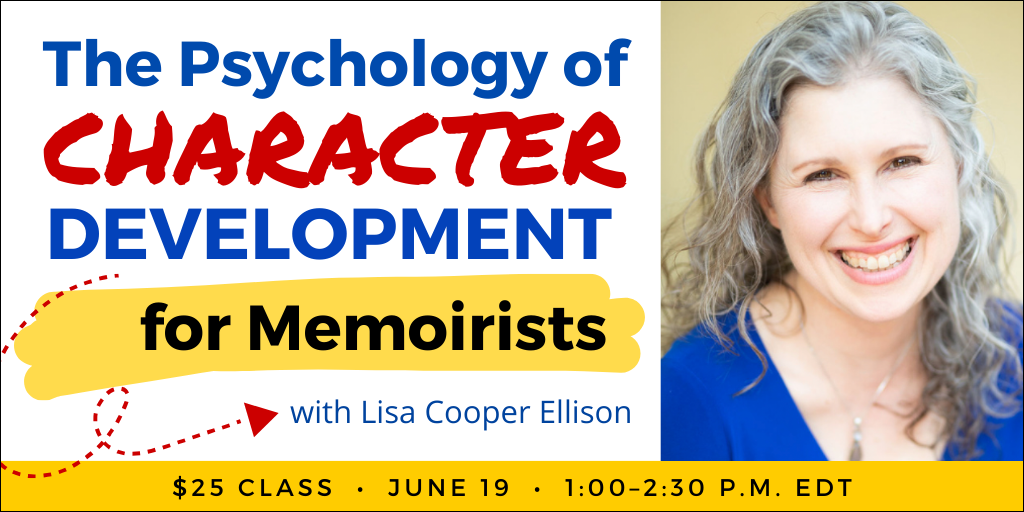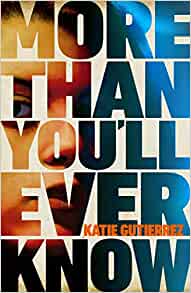
Today’s post is by writer and editor Lisa Cooper Ellison. Join her on Wednesday, June 19, for the online class The Psychology of Character Development for Memoirists.
In a previous career, I worked as an inner-city special education teacher. Many of my students were trauma survivors who’d experienced unspeakable violence. Some days books, chairs, and desks were thrown against the wall without warning. Hours later, the same student would smile and laugh as if nothing had happened. Sometimes we’d learn the reason for their outburst, but others remained a mystery—at least to us.
Many readers encounter stories with characters who are equally baffling. They act one way for a hundred pages, then do a 180 that violates what we know about them and their world, then carry on as if nothing strange happened.
When beta readers or critique partners flag this, some writers lean into the “show” side of “show don’t tell,” and add more gestures, facial expressions, and actions, hoping to clear things up. Others rush to insert flashbacks that explain their character’s psychological state. Occasionally a frustrated writer will say, “Don’t we all do strange things without understanding why? What if my art simply emulates life?” or “Maybe it’s the reader’s job to figure it out.”
Odd, confusing, and unexpected behaviors are a staple of real life, but in storytelling, the chain of events must make sense and move your story forward. That doesn’t mean spelling everything out for the reader. But you must know your characters’ motivations, so you can strategically plant clues that help the reader understand them.
Character motivation is an issue writers of all genres struggle with; however, memoirists face a few additional challenges. Unlike fiction writers, they can’t change situations to suit their stories, and the only lives they truly know are their own. They must dig deep into their psyches and observe others keenly to build realistic characters.
In graduate school, I encountered a quote that’s often attributed to the Austrian psychologist and neurologist, Viktor Frankl: “Between stimulus and response there is a space. In that space is our power to choose our response. In our response lies our growth and our freedom.”
In that space, we filter events through our internal landscape, which determines our actions and decisions. I created the C.I.A. formula based on this quote to help you understand how your character’s mindset influences their reactions in every scene.
Complicating Event + Internal Landscape = Action Taken by Your Character
First, a complicating event, or stimulus, occurs. This obstacle prevents your character from achieving their goal. It could be a boss entering with a stack of papers just as you’re leaving for a weekend trip, a traffic jam, or an argument with your spouse.
The action your character chooses in response to this stimulus could include something they say or do, or it could be a decision made by your protagonist that only appears as thought. The complicating event and action are what you see. They make up the plot.
A character’s internal landscape builds a bridge between the event and your character’s reaction. A character’s internal landscape consists of three components: their worldview, carry-in expectations, and carry-over issues between your characters.
Character worldview
Your character’s temperament and life experiences will shape their worldview. These experiences include events that cause core wounds, relationships that serve as protective factors, and deep needs that create blind spots that get them into trouble. A character’s viewpoint will shift as your story unfolds.
To establish your character’s worldview, have them behave as if they have a certain history. For example, let’s say your main character grew up in an alcoholic home and developed some codependent tendencies. You might include a flashback at some point that helps us understand this tendency, but in early chapters, all you need to do is show a character behaving codependently, perhaps by making excuses for a loved one’s bad behavior, trying to appease an angry spouse, or micromanaging their child’s recovery, something Ann Batchelder shows extremely well in her memoir Craving Spring.
Carry-in expectations
Most writers spend countless hours developing their main character’s worldview but often neglect to account for the influence carry-in and carry-over issues have on their behavior.
Carry-in expectations consist of the needs, desires, and emotional state your character brings into a scene. Some carry-in issues will stem from things that happen before your story begins, but it’s more effective to set most of them up inside your story.
For example, in the prologue for The Glass Castle, Jeannette Walls hides from her homeless mother as she heads to a party. Afterward, she’s so ashamed, she ruminates on her responsibilities to her parents. When she invites her mother to lunch at a Chinese restaurant a few days later, she carries in the guilt established in the opening scene as well as a sense of duty and history of trying and failing to help, which is developed through a few lines of interiority in scene number two.
Justin Torres masterfully weaves a set of carry-in issues into the second chapter of his semi-autobiographical novel, We the Animals, through a single page of flashback micro-scenes that explain why Justin and his brothers don’t question their mother’s confusion about what time it is.
Carry-over issues
Carry-over issues are issues between characters developed in earlier scenes and carried over into this one. Justin’s flashbacks are also great examples of carry-over issues, but here are a few more.
In a chapter titled “We Don’t Negotiate” from Laura Cathcart Robbins’s memoir Stash, the narrator and her husband have formally separated, but their divorce isn’t final. In a previous chapter, her lawyer instructed her not to negotiate with her husband. But that’s exactly what he asks her to do, saying “You know that’s what they want, right? The lawyers? … They want to pit us against each other and run up the bill.” Laura realizes they are living “in a siege state.” Part of her wants to give in, “but there’s too much at stake.” She carries over the escalating tension through some terse dialogue between the narrator and her soon-to-be ex, then reinserts the lawyer’s instructions with two quick lines of interior monologue. Do not negotiate with him outside of my presence. …Give him nothing.
In the chapter titled “Dream House as the River Lethe” from Carmen Maria Machado’s memoir, In the Dream House, the narrator endures a terrifying nighttime drive across several states to appease her volatile partner after she has a meltdown. Two carry-over issues influence her decisions in this scene: The partner’s reckless driving during a prior trip to Savannah and their recent conflicts.
Now you’re ready to insert clues readers can follow
Understanding your character’s worldview, carry-in, and carry-over issues will help you create a strong cause-and-effect chain that propels your story forward.
- In your book’s setup, reveal your character’s worldview by having them act as if they have a certain history through actions and internal monologue.
- For carry-in issues, you can include an occasional flashback, but better yet, show your character forming their beliefs and expectations during a critical scene’s emotional beat.
- When it comes to carry-over issues, develop conflicts or alliances early on. If the dynamics are obvious, nothing further is needed. Just have your characters continue with the current dynamic. If it’s subtler, or you need to emphasize the stakes, use a line or two of interior monologue, dialogue between your characters, or body language as a reminder.
Tactical decisions like this are how you can create art that truly emulates life. Best of all, inserting these clues and context will ensure no readers are baffled.

Note from Jane: If you enjoyed this post, join us on Wednesday, June 19, for the online class The Psychology of Character Development for Memoirists.
Lisa Cooper Ellison is an author, speaker, trauma-informed writing coach, and host of the Writing Your Resilience podcast. She works and writes at the intersection of storytelling and healing, and uses both her personal experiences and clinical training to help writers turn tough experiences into art. Lisa’s essays and stories have appeared on Risk! and in The New York Times, HuffPost, Hippocampus Literary Magazine, and Kenyon Review Online, among others.






